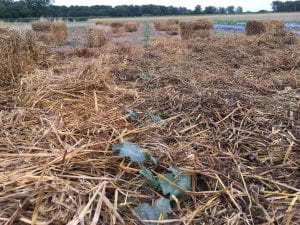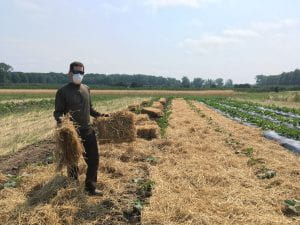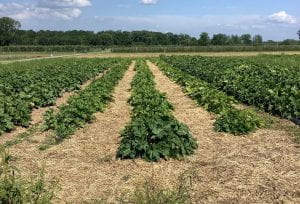Marcus Lopez, Bryan Brown, Abby Seaman
Spreading straw mulch is a great way for small scale farmers to manage weeds, but the presence of wheat or oat seeds presents a unique challenge. To encourage the grain to germinate prior to mulching, we set our straw bales outdoors to get wet from March to June, flipping them once to terminate any vegetation growing from the top. However, this gave rise to a new pest: fungus. Our bales were overrun with Coprinopsis atramentaria, the “inky cap mushroom.” What followed our spreading of these bales was a lot of stained clothing, and worse, respiratory irritation of some of our crew. It is recommended to wear an N95 mask when spreading straw bales, especially if they are moldy. We decided not to use the second half of our moldy straw bales, but instead buy new, dry bales. As a result, we will be seeing large communities of wheat sprouting in these plots. But since it was winter wheat, we think it will remain small and not head out prior to winter.
We applied our mulch at a rate of 9 ton/acre; about 600 small square bales per acre. 14 bales per 1000 ft². This application rate creates a thick layer of mulch that has been shown to be effective for the entire season. In addition to weed suppression, we have consistently measured higher soil moisture in our straw mulched plots, but lower soil temperatures.


Applying moldy straw, 7/1/21

Hardworking weed scientist sporting N95 mask while applying fresh straw, 7/7/21

Moldy straw holding down the fort one month in, 8/4/21
